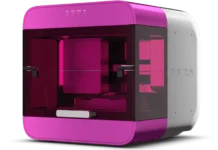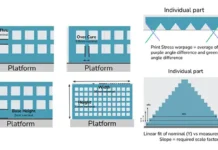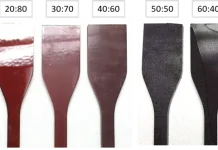By Dr. Jeffrey Stansbury, senior associate dean for research, professor and vice chair of the Department of Craniofacial Biology, University of Colorado School of Dental Medicine
Nanogel particles with very diverse structures have been produced by a wide range of synthetic strategies. There are collapsed, internally “cross-linked” single-chain polymers and self-assemblies of physically cross-linked components, as well as covalently cross-linked, multichain structures that all meet the characteristic description of discrete particles with dimensions below a few hundred nanometers. Nanogels are developed primarily for use in biomedical applications for controlled release of drugs and other therapeutics, as well as for biological imaging and sensing.1-3 They can be designed to be stimuli-responsive; however, they are rarely examined as modifiers or precursors of photopolymer networks, which is the focus of the work reported here using reactive nanogels as macromers.4
The nanogel structures adopted here derive from the fairly concentrated solution polymerization of mono- and di-vinyl monomers in the presence of a free radical initiator and a chain transfer agent (CTA). Along with the CTA, the solvent helps avoid macrogelation while also retaining internal free volume that allows for subsequent monomer infiltration.
Controlled radical polymerization approaches, such as reversible addition-fragmentation chain-transfer (RAFT), also have been used to form nanogels with well-controlled primary chain lengths.5 On the surface and within these nanogel particles, which are typically ~2 to 40nm in swollen dimension, there are large concentrations of chain ends because of the intentionally restricted chain lengths that result from the CTA or RAFT agents. The molar ratio of the di-vinyl monomers used in the nanogel synthesis vary from about 10% for low internal branching to 50% or even 80% for highly branched structures. In these nanogels, the crosslinks and cycles hold the particles in a globular form, while also allowing access to swelling by monomers or inter-particle overlap by inter-digitation. The particle size and the constituent molecular weight can be readily varied as well.
Also, great variations are possible in the monomers structures that can be employed in the nanogel synthesis. This allows for nanogels of wide-ranging glass transition temperatures (Tgs), refractive index or hydrophilicity to be considered. In all of these nanogel materials, reactive (polymerizable) functional groups are introduced to allow the nanogels to be used as macromers.

As an example of the versatility of this approach, an 80:20 molar ratio of isobornyl methacrylate (IBMA) and ethoxylated bisphenol A dimethacrylate (BisEMA) were reacted together in methyl ethyl ketone (MEK) with mercaptoethanol as a CTA. The mercaptoethanol chain-end groups then were used as a means to introduce polymerizable methacrylate functionality by reaction with isocyanatoethyl methacrylate. By slight changes in the solvent and CTA concentration in thermally initiated (azobisisobutyronitrile) solution polymerization, a wide range of nanogel molecular weights and sizes could be obtained. A practically useful feature of these nanoparticles is that as their size is reduced, the dispersion viscosity for a given loading level drops dramatically (Figure 1). This allows potential for very high loading levels of the reactive nanogels in resins, resulting in substantial reductions in polymerization shrinkage and stress, while significantly increasing the modulus relative to the resin control.6-8 The nanogel-modified resins remain completely transparent at any loading level before and after the final polymerization.

The placement (chain-end vs. pendant side-chain) and concentration of the reactive groups attached to the nanogels can be readily adjusted. The effect of varied reactive group concentrations on a common nanogel is shown in Figure 2. The percolation threshold for dispersed nanogels varies with both nanogel size and the relative solubility parameter of the dispersion media and nanogel. However, percolation is routinely observed in the 10-15 wt% loading levels, as determined by an ability to form a continuous macroscopic network in a solvent-dispersed nanogel photopolymerization (Figure 3). Near the percolation threshold, the reactive group consumption is primarily intra-particle in nature, while at approximately 50 wt% loading, which roughly corresponds to confluence between the overlapping nanogels, the reaction is both intra- and inter-particle. It is evident from Figure 2 that the inter-particle reactivity is quite efficient and that higher reactive group concentrations generally favor higher reaction rates.

Solvent-dispersed photopolymerizations at up to 80 wt% nanogel loadings have been conducted. Recent studies have examined the ability of solvent-evaporated, collapsed high Tg nanogel films, which can be designed as dense, homogeneous, monomer-free coatings, to undergo photopolymerization with high efficiency. Related to this, nanogels with Tgs below room temperature have been developed to allow monomer-free, solvent-free photocured coatings and photo-formed 3D structures. The polymerization shrinkage associated with these neat nanogels is minimal (~1 vol%) and, based on the placement and concentration of the reactive groups in the nanogel, the potential for a large ΔTg between neat nanogel and the macroscopic bulk photopolymer can be achieved. The nanogel structure and size also can be adjusted such that relatively low viscosity neat nanogels can be transformed to glassy photopolymers.
As described, there are a wide range of monomers that can be used to construct the nanogel particles. Hydrophilic or amphiphilic nanogels can be prepared and stably dispersed in water at any loading level.9,10 Mixtures of quite hydrophilic and amphiphilic nanogels have been used to make nano-heterogeneous networks with strength properties greater than either of the analogous networks prepared from the individual nanogels. Adhesives have been modified with nanogels to provide enhanced bond strengths and improved durability.11 The neat nanogel Tgs have been varied from approximately -40°C to more than 200°C, and this range – plus the ability to enhance or suppress the reaction rate of nanogel-infiltrated monomer – means that the local properties and the respective kinetics of property development inside and outside the nanogel domains in a nanogel-modified photocured resin can be altered to favorably affect overall photopolymer properties.12
Nanogels with refractive indices from about 1.4 to 1.7 have been achieved and used to modify the resin phase refractive index in composite materials as way to tailor the degree of optical transmission. Gradient structures have been developed based on self-segregation of polysiloxane nanogels within a photopolymer.13

Nanogel-modified resins have demonstrated very significant resistance toward oxygen inhibition. Nanogel addition not only enhanced the rate of polymerization in the closed films, but also increased the rate of the open film to match that of the closed film control (Figure 4). Degradable linkages have been designed into the nanogel structures that then are used to make macroscopic networks. The rate of degradation can be tuned from hours to weeks or months, based on the nanogel composition and whether the degradable linkages are situated internal to the nanogel building blocks, external as the inter-particle connections or both. On the other hand, non-degradable nanogels have been used to reinforce secondary networks that otherwise are susceptible to thermal or hydrolytic degradation.
Acknowledgement
This work was supported by the NIH/NIDCR (R01DE022348 and R01DE023197), the Industry/University Cooperative Research Center for Fundamentals and Applications of Photopolymerization, as well as Dentsply.
Literature cited
- Sivara, A.J.; Rajitha, P.; Maya, S.; Jayakumar, R.; Sabitha, M. Nanogels for delivery, imaging and therapy. Wiley Interdiscip Rev Nanomed Nanobiotechnol 2015; 7:509-33.
- Jiang, Y.J.; Chen, J.; Deng, C; Suuronen E.J.; Zhong, Z.Y. Click hydrogels, microgels and nanogels: Emerging platforms for drug delivery and tissue engineering. Biomaterials 2014; 35:4969-85.
- Liu, G.Y.; An, Z.S. Frontiers in the design and synthesis of advanced nanogels for nanomedicine. Polym Chem 2014; 5:1559-65.
- Dailing, E.; Liu, J.; Lewis, S; Stansbury, J. Nanogels as a basis for network construction. Macromol Symp 2013; 329:113-7.
- Liu, J.C.; Stansbury, J.W. RAFT-mediated control of nanogel structure and reactivity: Chemical, physical and mechanical properties of monomer-dispersed nanogel compositions. Dent Mater 2014; 30:125262.
- Moraes, R.R.; Garcia, J.W.; Barros, M.D.; Lewis, S.H.; Pfeifer, C.S.; Liu, J.C.; Stansbury, J.W. Control of polymerization shrinkage and stress in nanogel-modified monomer and composite materials. Dent Mater 2011; 27:509-19.
- Liu, J.; Howard, G.D.; Lewis, S.H.; Barros, M.D.; Stansbury, J.W. Shrinkage stress reduction and mechanical properties in nanogel-modified resin systems. Eur Polym J 2012; 48:181928.
- Liu, J.C.; Howard G.D.; Lewis, S.H.; Barros, M.D.; Stansbury, J.W. A study of shrinkage stress reduction and mechanical properties of nanogel-modified resin systems. Eur Polym J 2012; 48:1819-28.
- Dailing, E.A.; Lewis, S.H.; Barros, M.D.; Stansbury, J.W. Construction of monomer-free, highly crosslinked, water-compatible polymers. J Dent Res 2014; 93:1326-31.
- Dailing, E.A.; Setterberg, W.K.; Shah, P.K.; Stansbury, J.W. Photopolymerizable nanogels as macromolecular precursors to covalently crosslinked water-based networks. Soft Matter 2015, 11:5647-55.
- Moraes, R.R.; Garcia, J.W.; Wilson, N.D.; Barros, M.D.; Lewis, S.H.; Pfeifer, C.S.; Stansbury, J.W. Improved dental adhesive formulations based on reactive nanogel additives. J Dent Res 2012; 91:179-84.
- Liu, J.; Rad, I.; Sun, F.; Stansbury, J.W. Photoreactive nanogel as a means to tune properties during polymer network formation. Polym Chem 2014; 5:227-33.
- Chen, C.; Liu, J.; Sun, F.; Stansbury, J.W. Control of microstructure and gradient property of polymer network by photopolymerizable silicone-containing nanogel. J Polym Sci: Polym Chem 2014; 52:2830-40.
Dr. Jeffrey W. Stansbury is senior associate dean for research, and a professor and vice chair of the Department of Craniofacial Biology at the University of Colorados School of Dental Medicine. He joined the polymers division at the National Institute of Standards and Technology (NIST) and remained there for 21 years, working on a variety of biomaterials and materials characterization techniques. Stansbury moved to the University of Colorado in 2000 to join the School of Dental Medicine in developing a biomaterials program, and he also was appointed to the Department of Chemical and Biological Engineering in Boulder. He maintains research laboratories on the Boulder and Anschutz Medical Campuses, with work focused on a variety of fundamental and applied areas involving dental materials, polymer networks, photopolymerization and bioengineering. Contact Jeffrey Stansbury at jeffrey.stansbury@ucdenver.edu.






